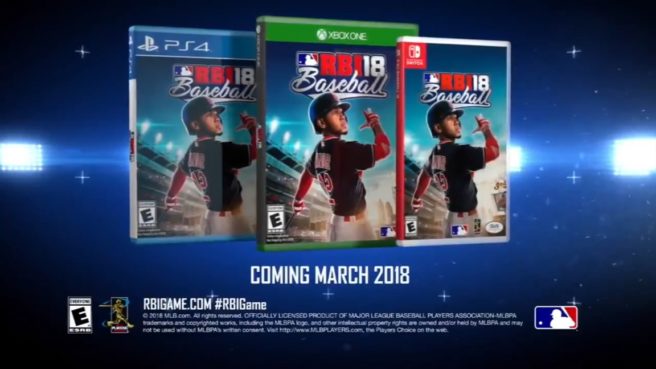First R.B.I. Baseball 18 details and screenshots – major improvements and new features
Polygon was recently able to get a look at R.B.I. Baseball 18, which was announced for Switch this weekend. The site has details on major improvements planned for this year’s game, as well as new features.
Here’s a roundup of the information we have so far, along with first screenshots:
– Game isn’t being worked on by an external team this time
– MLBAM’s gaming department now consists of more than 30 people who are working primarily on R.B.I. 18, many of whom were hired within the past year, plus some external contributors to help with specialized fields
– Alexander Reyna, director of experience design for gaming and VR at MLBAM, says the R.B.I. series “has suffered a little bit of an identity crisis in the past”
– They want “to have a visual identity that feels consistent for our product”
– Improving the visuals was a top priority
– The team “reworked literally everything”, including character models and the way they’re rendered, plus the animation systems
– There aren’t just three body types anymore
– The developers added true-to-life animations for elements like batting stances and pitching motions
– MLBAM is implementing hundreds of character models using data from face scans
– More dynamic camera system zooms in on players in certain circumstances and is smarter in providing the right perspective on fielding plays
– Amateurish sound effects and music snippets found in the older titles have been replaced with licensed music
– Menu interface has been overhauled with a modern tile-based design
– Will cost $29.99 on Switch
– Home Run Derby contest mode added for the first time
– This mode will support networked leaderboards
– Full franchise mode added
– It’s a major expansion of the existing setup, which allows for playing multiple seasons but without any persistent year-to-year tracking of statistics
– MLBAM decided on a mode that runs for up to 10 seasons
– Upon completion, it rates the player’s performance with a letter grade that’s based on their win-loss record and the number of World Series titles they won
– Built into the mode is some “weighted randomness” in player progression, which is a way to introduce variability in the arc of each athlete’s career
– The game maps existing players onto various preset trajectories: Older athletes are more likely to retire within a few seasons, while younger stars will stick around
– The franchise mode supports trades and injuries, although the AI won’t initiate trades
– Wrinkle to roster management: Over 100 MLB “legends” from bygone days are available in the free agent pool, split into two sections – those who retired in 1990 or later and those who retired before that year
– The mode lets users import roster updates after they’ve started playing
– If a team calls up a prospect halfway through the 2018 season, and MLBAM adds him to R.B.I. 18 in a subsequent downloadable roster, even if you started a franchise in March, the game will let you import the latest file to get your playthrough up to date
– You’ll have two choices: overwriting the rosters entirely, or adding new players only
– Either way, you won’t lose any progress or accumulated statistics
– Devs wanted to keep it simple and not have stuff like managing minor league rosters
– Along with minor league players, money is nowhere to be found in R.B.I. 18’s franchise mode
– Schreiber says that “the core for R.B.I. Baseball is maintaining a streamlined, fun experience,” although MLBAM can always go deeper in future years if fans ask for increased complexity
– More has been invested in this year’s game than any other R.B.I. title



